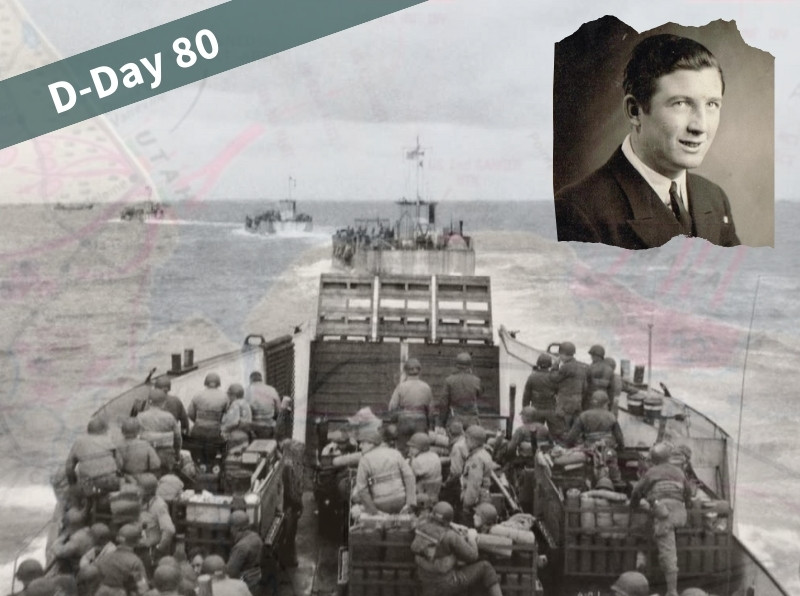Stories from our community for the 80th anniversary of the Normandy landings
We’ve reached a major anniversary in the history of WWII: D-Day 80, 80 years since the launch of Operation Overlord, when Allied forces stormed the beaches of Normandy on 6 June 1944 in what is the largest amphibious invasion in history. We look back on that momentous day in WWII with tales of courage and bravery from Forces War Records community members whose fathers took part in the invasion. In part 1 of the series, we discover the story of William Denning, a Royal Navy sailor who had an important role to play in landing troops on Utah Beach.
D-Day 80: The path to victory
D-Day, or Operation Overlord, was a huge, ambitious operation, seeing over 156,000 Allied troops land in Normandy, Northern France, either by air or on the beaches. The invasions marked a significant turning point in WWII, providing the Allies with a foothold in occupied North West Europe on which to build.
Before the D-Day beach landings
Prior to the seaborne invasion, 18,000 airborne troops of the US 82nd and 101st Airborne Divisions and the British 6th Airborne Division began landing behind enemy lines just after midnight by parachute or by glider. Their objectives were to secure areas of importance behind the beaches and on the flanks, like bridges, road crossings and coastal batteries, to help the invading forces.
The beach landings
The five D-Day beaches targeted by the Allies were Utah, Omaha, Gold, Juno and Sword.
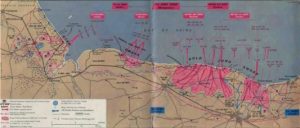
The first waves of troops landed on Utah and Omaha beaches at around 06:30 on 6 June 1944, with the first waves landing on Gold, Juno and Sword beaches at different times over the next hour and a half. More than 61,000 of the landing forces were British. Over 11,500 aircraft were made available to support the landings, with the invasion force comprising 7,000 ships and landing craft operated by 195,000 naval personnel from eight allied countries. It was an incredible feat of planning and multi-national effort.
D-Day 80: William’s story
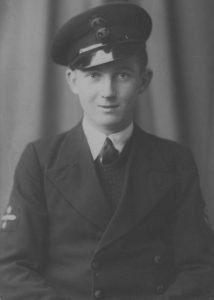
Anthony, who follows Forces War Records on Facebook, has a strong connection to the Normandy landings through his father William. Willliam Denning was born in 1922 in Berkeley, a small Gloucestershire town located between Gloucester and Bristol. According to the 1939 England and Wales Register, available on Ancestry, William was employed as a motor mechanic when war was declared in September 1939.
William enlisted in August 1941, aged 19, bidding farewell to his widowed father and younger brother. He joined the Royal Navy as a Motor Mechanic, almost certainly based on his civilian trade in this field. He was initially posted to HMS Caroline in Belfast, where he underwent training. According to William’s service record, provided by Anthony, before D-Day, William was stationed at HMS Dinosaur, based in Troon, Ayrshire, the HQ specialising in tank landing craft training operations and included a landing craft gunnery school. William and his comrades underwent vital training ahead of the big invasion of North West Europe.
FWR Tip: If, like Anthony, your ancestor served with the Royal Navy during WWII, you can apply for their service record online via the Ministry of Defence website. This will help you to establish which ships they served aboard and when, allowing you to piece together their wartime service.
In early 1944, William was posted to 107 LCT (Landing Craft Tank) Flotilla, serving on board Landing Craft Tank (LCT) 2011. LCT 2011 was designated ‘A’ for ‘Armoured’ and was equipped with the firepower of two tanks, much needed for the task of approaching the Normandy beachhead during the invasion.
FWR Tip: Some ships’ logs for various landing craft are available from The National Archives and can reveal details of the ship’s daily activities.
Invasion on the horizon
As D-Day approached, there was no time to lose; William married his fiancee Eva Jeremy in Cardiff in April 1944. In times of war, there was no knowing who would return home and what opportunities would be lost. The invasion of North West Europe was just around the corner.
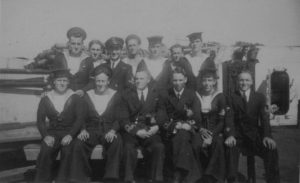
Delving into our US WWII naval war diaries in the lead-up to Operation Overlord, we discovered that on 3 June, LCT-2011 was one of many ships anchored in Torbay, Torquay.
Sources suggest that other LCTs in Force U, to which LCT-2011 belonged, having loaded their men and equipment destined for Utah Beach, left Brixham in Torbay on 3 June in preparation for the invasion, reaching the south of the Isle of Wight late on 4 June; it is probable that this convoy also included LCT-2011. The LCTs began their journey across the Channel that night, but in the face of adverse weather conditions, Overlord was postponed for 24 hours. The delay must have been agonising for William, his Royal Navy comrades, and the US personnel crammed on board the LCTs. The dejected crew made their way back to the South Coast of England.
The following day, 5 June, Operation Neptune, the assault phase of the operation, was given the green light, and the LCTs of Force U set out for Normandy once more. They made their way through the ‘swept channel‘ to the Assault Area. A huge minesweeping operation had cleared a safe area known as the ‘Spout’ for the ships to pass through. The minesweepers had done their dangerous job well.
Some ships still anchored in Torbay would soon be joining Force U in the Channel. The US naval war diaries provide a captivating account of their journey, noting ‘friendly aircraft passed overhead continuously’, adding to the magnitude of the event. Allied air superiority was clearly paying off. The diary continues: ‘Red and green Allied aircraft pathfinder flares were observed off the starboard beam, lighting up the beach. This bombing and anti-aircraft fire continued to be seen during the remainder of the approach to the Transport Area and until 06:30 of the 6th.’
US troops began landing on Utah and Omaha beaches at around 06:30 on the 6th. The Royal Navy and the Royal Marines operated many of the landing craft used during the invasion; the latter crewed two out of three of the landing craft.
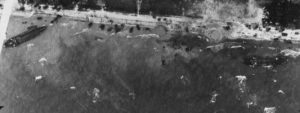
Getting to the shore
On 6 June, William and his Royal Navy crew had the immense responsibility of ferrying American soldiers and equipment from the US 238 Engineer Combat Battalion to the beach. Records suggest the 238th Combat Engineers landed from 07:00 to 11:00 on D-Day, with the majority touching down on Utah Beach in the first hour. Delving into the US war diaries once more provides a fascinating insight into the movements of the landing craft towards the beach and the events unfolding around William and his crew:
’06:30 was H-Hour for this operation. 07:15 Waves of LCMs [Landing Craft Mechanised] and LCTs began moving towards the beach. LSTs [Landing Ship Tank] followed these waves and soon the immediate area around the Transport Area was bare of landing craft. 07:35 Four of the Barnett’s LCVP’s [Landing Craft, Vehicles, Personnel] returned to the ship. The boat officer reported that the first wave landed at 06:31, one minute late. Attack boats and LCT’s continued returning from the beaches, many of them delivering casualties and survivors of demolished craft to the Barnett and Joseph T. Dickman.’
FWR Tip: H-Hour was the landing time on D-Day.
Reflecting 80 years later, it is impossible to comprehend what William and his comrades experienced on that pivotal day during WWII.
In 2014, Anthony visited the D-Day beaches. Along with his sister Angela and brother-in-law Christopher, who came all the way from Australia, they made the poignant trip to Normandy to visit where William had played an important role in the momentous invasion of North-West Europe:
‘I think it was very brave of my dad…I feel very proud of what he did, like most who served, he probably saw it as a job that had to be done, and never talked about afterwards.’
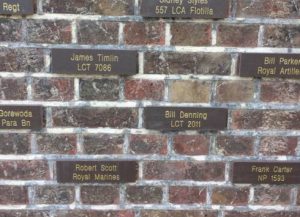
William’s efforts during the invasion didn’t go unnoticed. For his service in connection to the Normandy Landings, now Petty Officer Motor Mechanic William Denning was Mentioned in Dispatches:
‘For outstanding courage, leadership and skill during the build-up of the Normandy bridgehead’.
William appears to have served with LCT 2011 for the remainder of the war and was released to shore in March 1946. His name appears on a brick on the Normandy Memorial Wall in Portsmouth, bearing the names of those who took part in the campaign. Friends and family members of those who served during Operation Overlord can commission a brick in the memorial.
Stay tuned for part 2 of our D-Day 80 community stories series, where we’ll meet Norman Davies, the British Army soldier who stormed Sword Beach with his battalion on 6 June 1944.
This blog is largely based on the information provided by the community member and records where available.
Cover image: Landing craft: ©IWM (HU 102348). Image of William provided by Anthony Denning.
Sources
Combined Operations, Landing Craft Tank (5) 2331 – LCT (5) 2331, accessed May 2024.
Combined Operations, Landing Craft Tank (5) 2304 – LCT (5) 2304 on D Day, accessed May 2024.
Combined Operations, UK Land Based Training Establishments, accessed May 2024.
Dwight D. Eisenhower Presidential Library, Museum, and Boyhood Home, World War II: D-Day, The Invasion of Normandy, accessed May 2024.
National Army Museum, D Day, accessed May 2024.
NavSource, Landing Craft Tank (LCT), accessed May 2024.
Royal Navy, The Royal Navy at D-Day 75, accessed May 2024.
The D-Day Story Portsmouth, The D-Day Story Collection, accessed May 2024.
The D-Day Story Portsmouth, What is D-Day?, accessed May 2024.

